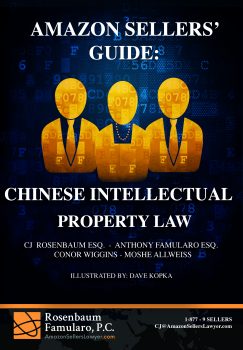
Amazon Sellers’ Guide: Chinese IP Law
By: CJ Rosenbaum Esq., Anthony Famularo Esq., Conor Wiggins, and Moshe Allweis
Chapter Two:
Understanding Your Intellectual Property Rights in China ……….. 10
What Is A Copyright? ……….. 10
What Is A Trademark? ……….. 12
What Is A Patent? ……….. 14
What Is Trade Dress? ……….. 15
What Are Trade Secrets? ……….. 17
Chapter 2: Understanding Your Intellectual Property Rights in China
The World Intellectual Property Organization (“WIPO”), defines “intellectual property” as “creations of the minds such as inventions; literary and artistic works; designs; and symbols, names and images used in commerce.”
 The phrase “intellectual property,” first and foremost, is an umbrella-term for copyright, trademark, patent, trade dress and trade secret.
The phrase “intellectual property,” first and foremost, is an umbrella-term for copyright, trademark, patent, trade dress and trade secret.
This chapter’s goal is to provide basic explanations of these rights as they pertain to Sellers and introduce any distinct definitional differences that these rights may have in China when compared to the international community under the WIPO or in the United States.
(I). What Is A Copyright?
Copyright protection in the United States is derived from Article I Section 8 of the U.S. Constitution which grants Congress the power to “promote the progress of science and useful arts, by securing for limited times to authors and inventors the exclusive right to their respective writings and discoveries.” In essence, copyright protection grants the “author” the exclusive-right to use their copyright to their economic benefit and no one else’s without that author’s permission to do so. In the United States, copyright protection, for any work created after January 1, 1978, lasts for the lifetime of the author plus an additional 70 years. In China, copyright protection lasts for the lifetime of the author plus fifty years.
Copyright protection in China may be granted by filing a domestic-Chinese application in accordance with the Copyright Law of the People’s Republic of China. Alternatively, protection in China may be obtained for a work “published outside the territory of the People’s Republic of China which is eligible to enjoy copyright under an agreement concluded between the country to which the foreigner belongs and China, or under an international treaty to which both countries are parties.”
CJ’s Side Note: There will be more on the details on the several different ways of how to apply for copyright protection in China. For now, however, it is only important to understand that there are multiple ways to gain copyright protections.
Under Chinese copyright law, copyright protection extends to “works of literature, art, natural science, social science, engineering technology and the like which are expressed in the following forms:
1. Written works;
2. Oral works;
3. Musical, dramatic, quyi’, choreographic and acrobatic works;
4. Works of fine art and architecture;
5. Photographic works;
6. Cinematographic works and works created by virtue of an analogous method of film production;
7. Drawings of engineering designs, and product designs; maps, sketches and other graphic works and model works;
8. Computer software;
9. Other works as provided for in laws and administrative regulations.”
As is clear from this list, copyright protections in China extend to a wide array of works: from writings to computer software, from videos to architecture.
(II). What Is A Trademark?
 A trademark is “any word, name, symbol, or design or any combination thereof, used in commerce to identify and distinguish the goods of one manufacturer or seller from those of another and to indicate the source of the goods” . A trademark signifies for the consumer that the product he or she is purchasing will deliver the same consistent quality that has been associated with that good.
A trademark is “any word, name, symbol, or design or any combination thereof, used in commerce to identify and distinguish the goods of one manufacturer or seller from those of another and to indicate the source of the goods” . A trademark signifies for the consumer that the product he or she is purchasing will deliver the same consistent quality that has been associated with that good.
China is the most robust market for trademark applications in the world. In 2016, 3.691 million trademark applications were filed by Chinese people and companies.
Anthony’s Breakdown: The Nike swoosh, the stylized way the Hewlett-Packard Company (HP) writes “hp,” and the Starbucks mermaid are all examples of valid trademarks. As soon as you see any of these symbols or lettering, you know the exact source of the product you are buying and already have an expectation for the product’s quality based on that brand’s goodwill and reputation.
While there are a vast array of words, names, and symbols that can be registered for trademark protection, many things cannot be registered. Generic words and pictures of items that naturally grow or exist in nature are not eligible for trademark protection.
There is little definitional difference in China, as opposed to in the United States or internationally, as to what a trademark is. One distinct difference, however, is that the Chinese Trademark Office (CTMO) does not require applicants to prove that they are using their mark at the time of application.
China allows companies to register their trademark for multiple classes of trademark regardless of whether they ever intend to use the trademark in that way. This system is called “first-to-file” and is one of the issues which may confront a seller entering the Chinese market.
The “first to file” system can be advantageous to prepared Sellers or corporation. One such foreign company that has taken advantage of this in China is Starbucks, which has registered their STARBUCKS trademark in all 45 classes of Chinese-trademarks under the CTMO.
(III). What Is A Patent?
Patents protect novel and non-obvious inventions and technological processes. Patents are registered in China through S.I.P.O. (State Intellectual Property Office of the People’s Republic of China), which governs all patentable material in China.
China is the international hub of patent filings. In 2016, there were more patent applications in China than in the United States, Japan, the Republic of Korea, and the European Patent Office combined.
When a party wins a patent-infringement claim, they may be able to recover 100% of all the profits made by the sale of that product. A 100% recovery can be devastating to even the largest companies.
(IV). What Is Trade Dress?
In the United States, trade dress protects the “overall appearance” of the product so long as the trade dress is both “inherently distinctive” and the alleged-copier’s trade dress is “likely to cause consumer confusion.” Trade Dress protects a product’s and a color schemes, packaging, and other aspects of the product.
In China, there is no specific law of trade dress. In China, trade dress can be protected under copyright law, trademark law, patent law, and unfair competition law. While there is no specific trade dress law, because this protection can be invoked under all different fields of Chinese intellectual property, it makes trade dress a potential avenue for a seller to protect their products and their appearance. This defensive tactic will be elaborated on further in chapter seven.
(V). What Are Trade Secrets?
A trade secret is a form of intellectual property protection that protects against others from using information that is valuable because it is not known in the trade. To qualify, the information has to be secret and the information holder must continuously take reasonable measures to keep the secret.
Trade secret law generally protects what the lay person would consider to be a “secret recipe,” or whatever makes a product unique and one-of-a-kind and gives it a competitive edge in that marketplace (i.e. inventions, designs, ingredients, algorithms).
Anthony’s Breakdown: Coca-Cola’s recipe, the criteria for the New York Times Bestseller list, Google’s search algorithm, Twinkies’ ingredients are all examples of famous trade secret protections.
Trade secret theft is a significant problem in China. In 2011, an employee of a Massachusetts-based wind turbine company that had begun doing business in China was arrested and sentenced to a year in prison for selling the “crown jewel” trade secrets of the company for an offer of $2 million, women, apartments, and a new life in China. Stories like this are not uncommon in China. Sellers should be very protective of their trade secrets.
Similar to trade dress, there is no specific trade secret law in China. A seller can, however, gain trade secret protection under Article 10 Section 3 of Unfair Competition Law. Article 10 prohibits business owners from infringing upon trade secrets by: stealing, luring, intimidation or any other unfair means. As a result, knowledge of what secrets are important to a seller’s products, and the means by which to protect these secrets, makes the protection of trade secret another important component of any seller’s intellectual property protections.
Chinese IP Law: Chapter 2 – Conclusion
Intellectual property is a blanket term for a wide array of protections that a seller can obtain to protect themselves from potential infringers of their products. The first step in a seller equipping themselves with a bundle of intellectual property protections is understanding all the different types of protections, what they are, and what they protect.
